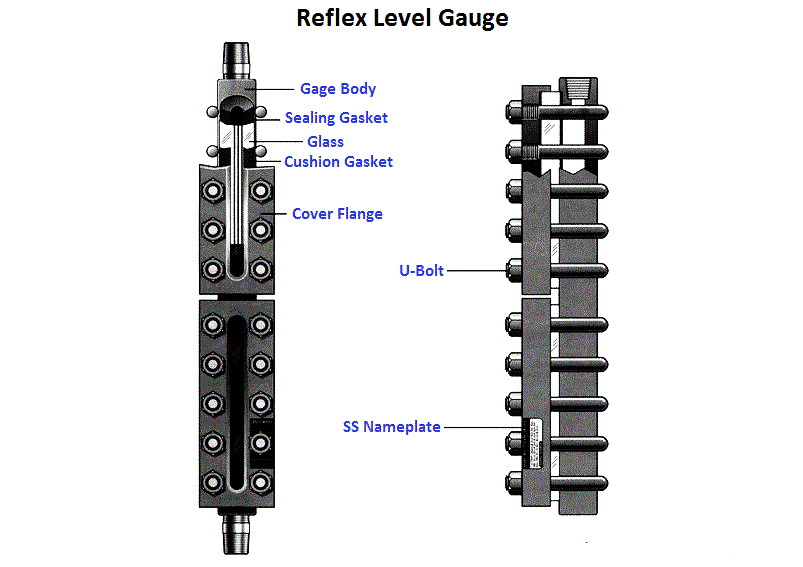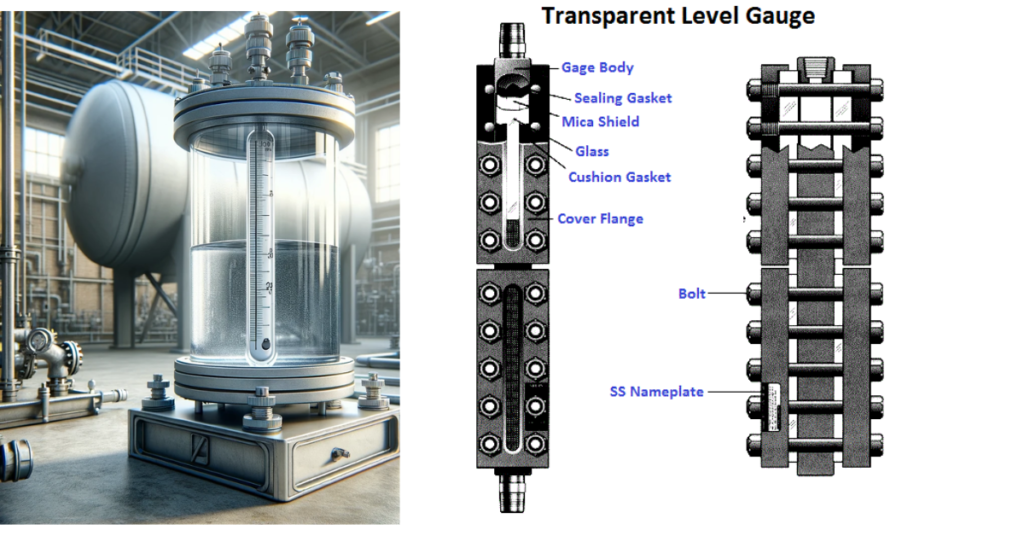Explore different types of level gauges, their uses, and how to select the right one for your needs in our expert guide
Level gauges are essential instruments used in various industrial and engineering fields to measure the level of liquids, gases, or granular solids within a container or system. These devices provide crucial data that can affect the safety, efficiency, and operational success of industrial processes. This article delves into three common types of level gauges: reflex, transparent, and magnetic level gauges, exploring their applications, advantages, and limitations.
Reflex Level Gauge
A reflex level gauge operates using the principle of light refraction and reflection through a specially designed prismatic glass. The glass has ridges on one side, which face the liquid and reflect light differently depending on whether they are in contact with liquid or vapor. This makes it easier to visually distinguish the liquid level within the tank.

The reflex level gauge is specifically designed to provide a clear visual indication of the liquid level within a container by exploiting the differences in the optical properties of liquids and gases (vapor). The design and functionality of the gauge are optimized to distinguish between the liquid zone and the gas (or vapor) zone. Here’s how these zones are defined and function within the context of a reflex level gauge:
Liquid Zone
In the liquid zone of a reflex level gauge, the prismatic glass on the front face of the gauge comes into contact with the liquid. The prisms are designed so that when the liquid is present, it fills the glass grooves and allows light to pass through with minimal reflection. This makes the liquid zone appear dark when viewed from the front. The reason for this darkness is the liquid’s absorption and minimal reflection of light, enhancing visibility and contrast between the liquid and gas zones.
Gas/Vapor Zone
Conversely, in the gas or vapor zone, no liquid fills the grooves in the prismatic glass. The glass structure causes the incident light to reflect significantly due to the presence of air or vapor. This reflection causes the gas/vapor zone to appear much brighter or silvery, contrasting sharply with the darker liquid zone. This distinct visual difference makes it easy for operators to determine the exact liquid level within the tank or vessel.
Applications
Reflex level gauges are predominantly used in industries where accurate level measurement is critical under high-pressure conditions. Common applications include boilers, feedwater heaters, oil/water separators, and other vessels in the chemical, petrochemical, and processing industries.
Limitations
The main limitation of reflex level gauges is their use with certain fluids. They are less effective with very clean or demineralized liquids where the difference in refractive indices between the liquid and the vapor phase is minimal. Additionally, over time, the glass can become etched by corrosive fluids or clouded by sediment, requiring regular maintenance or replacement.
Transparent Level Gauge
Transparent level gauges feature a simple design consisting of a transparent glass tube through which the tank’s contents can be directly observed. This gauge type allows for the visualization of not just the liquid level but also the characteristics of the liquid itself, such as color and clarity.

Transparent level gauges are designed to provide a direct visual observation of liquid levels within tanks and vessels. The construction of these gauges is relatively straightforward, emphasizing visibility and durability.
Components:
- Glass Plates: The core component of a transparent level gauge is one or more pieces of strong, transparent glass. This glass needs to withstand the pressure, temperature, and chemical nature of the fluid it is in contact with. Typically, these are made from borosilicate glass and are highly resistant to thermal shock and chemical corrosion.
- Body: The gauge’s body is typically constructed from metal, such as stainless steel or brass. It houses and protects the glass plates and includes a chamber that aligns with the fluid level in the vessel.
- Seals and Gaskets: Seals and gaskets prevent leaks and secure the glass within the body. They are usually made from materials such as Teflon or Viton and are resistant to heat and chemical degradation.
- Valves: Valves are incorporated into the design to isolate the gauge from the process fluid during maintenance or in case of glass breakage. These valves often have a safety mechanism that automatically shuts off the flow if the glass breaks.
- Vent and Drain Plugs: To facilitate maintenance, cleaning, and flushing of the gauge, vent and drain plugs are included in the design.
Assembly:
The assembly involves mounting the glass plates securely within the metal body, ensuring airtight sealing with gaskets. The complete gauge is then mounted to the tank or vessel with side connections, aligning it with the fluid level inside. The connections are usually at the top and bottom of the gauge.
Applications
This gauge type is commonly employed in tanks or vessels where it is beneficial to inspect the fluid visually. Applications can be found in food and beverage industries, pharmaceuticals, and any application involving corrosive liquids, where operators must observe the physical characteristics of the fluid beyond just its level.
Limitations
The visibility through transparent level gauges can be hampered by the deposition of sediments or scaling, which necessitates regular cleaning. Furthermore, these gauges are unsuitable for opaque or very dense liquids with limited visual clarity. They also tend to be more fragile than other gauge types and are limited in their application by the maximum pressure and temperature the glass can withstand.
Magnetic Level Gauge
Magnetic level gauges are modern instruments used to measure the fluid levels in tanks and vessels without direct contact between the indicators and the fluid itself. They offer a reliable and safe method for monitoring liquid levels, especially in high-pressure, high-temperature, or hazardous environments.

Magnetic level gauges consist of a float containing a magnet inside a sealed tube, which moves up and down with the liquid level. Outside the tube, a visual indicator strip contains magnetic followers that flip or rotate as the magnetic float passes by, indicating the liquid’s level.
Construction of Magnetic Level Gauges
The construction of a magnetic level gauge typically involves several key components:
- Float Chamber: This sealed, non-magnetic tube contains the liquid whose level is being measured. It is often made of robust materials like stainless steel to withstand harsh conditions.
- Float: Inside the float chamber, a magnetically activated float containing one or more permanent magnets is designed to have a specific gravity slightly less than the liquid it measures, allowing it to float at the liquid surface.
- Indicator System: Mounted externally along the side of the float chamber is an indicator strip. This strip includes a series of magnetic followers or flags. These indicators are magnetically coupled to the float and rotate or flip when the magnet inside the float moves up or down with the liquid level.
- Transmitter and Switches: For remote monitoring and control, magnetic level gauges can be fitted with transmitters that convert the float’s position into a 4-20 mA electrical signal. Magnetic switches can also be added for high and low-level alarms or to control pumps and valves.
Applications
This gauge type is highly versatile and is used in a wide range of industrial applications. It is particularly useful in high-pressure, high-temperature processes or hazardous materials, as there is no direct contact between the liquid and the indicator. Typical applications include storage tanks for fuels and chemicals and nuclear power plants.
Limitations
While magnetic level gauges are generally robust and reliable, they can be susceptible to issues if the float’s magnet becomes demagnetized or if debris within the tank obstructs it. Furthermore, their accuracy can be affected by rapid changes in the fluid’s density or viscosity, which may cause the float to provide a delayed or inaccurate reading.
Conclusion
Level gauges are critical components in many industrial systems, each type bringing its own set of strengths and challenges. Reflex gauges are preferred for their distinct visual contrast in many conditions; transparent gauges offer direct visual access to the fluid’s characteristics, and magnetic gauges provide robust performance in harsh environments. Understanding the specific needs of an application and the limitations of each gauge type is essential for selecting the right level gauge and ensuring its effective operation.
Read Next: